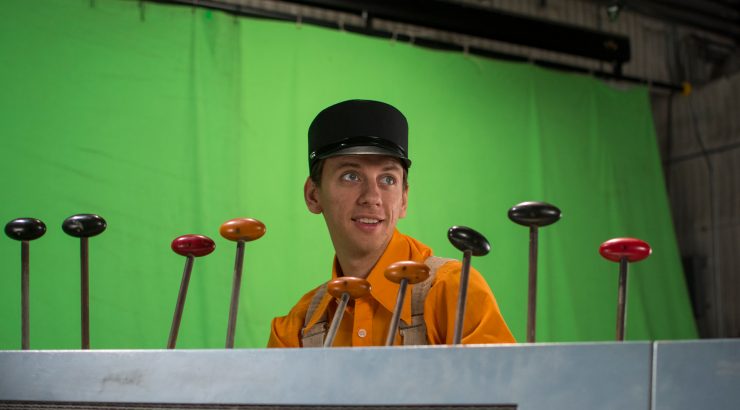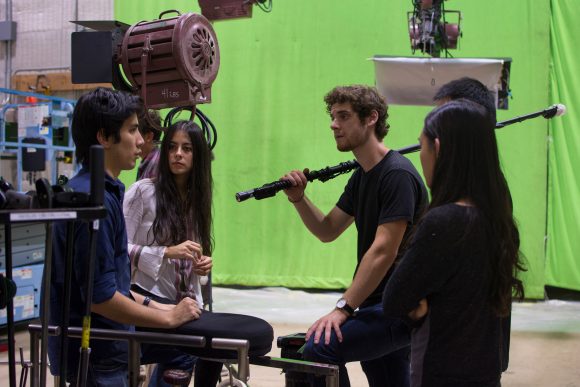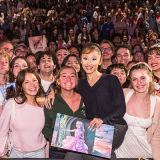
VFX at Chapman Preparing to enter the dizzying, dazzling world of visual effects
June 25, 2018
Many freshmen entering the Animation and Visual Effects program at Dodge College this year were born the year The Matrix was released—in effect, they have been surrounded by stunning visual effects their entire lives. Just as Keanu Reeves (Neo) fights to find his way out of the matrix, today’s aspiring young filmmakers are often fighting to get into the industry that created that eerie computer-controlled world.
The Visual Effects (VFX) program has grown to match their needs and desires. With the arrival of program director and Professor Bill Kroyer, an Oscar-nominated animation director, and 35-year Hollywood veteran, what was once a bare-bones set of classes began to be shaped by connections—through Kroyer—to the top artists in the industry who have helped revise the curriculum to meet industry standards. As an area of study within the Animation and Visual Effects program, studies in VFX have been further supplemented by the addition of a minor in VFX and, most recently, a minor in Virtual Reality and Augmented Reality (VRAR).
Whichever path a student chooses, a key advantage of studying visual effects at Chapman is its home within the #6 film school in the nation. “For all practical purposes, our students have the opportunity to work as if we were a VFX house serving a major film studio. With all of the live action production at Dodge, our students have endless opportunities to partner with production students, both grad and undergrad, to practice their art and craft,” says Kroyer.

Ben Jannasch (BFA/DA ’18) is exactly the kind of student who takes advantage of this opportunity. Starting as a young boy interested in cartooning, Jannasch moved from drawing to filming but was frustrated that he couldn’t capture everything in his imagination as he done with his drawings—until he discovered the world of visual effects in high school. At Chapman, he values “continuing to push both my passions of production as well as VFX,” with the goal of becoming a VFX supervisor both “on set as well as during the post-production process.”
Professor Adam Rote, a visual effects artist who has worked on films big and small (Iron Man 3, Man of Steel, Minority Report, Cats and Dogs) as well as a wide variety of video games (the Star Trek series, among others), teaches several of the primary VFX courses. For Rote, the biggest challenge is “the daunting task of getting the students up to speed with the amount of software that is needed and used for each and every project in a progressive, yet understandable way.”
His approach is to teach the class “more like team building, just like I have done as Lead Artist or VFX Supervisor on the job with a team of artists.” He asks more advanced students to help those who need more assistance. At the same time, he pushes his students to practice each new skill immediately after class and on a continuing basis because “Knowledge is like water. It evaporates quickly if not used daily.”
In working with live action students, Rote finds that they often underestimate how long it can take to create effects or they misunderstand the process, making mistakes such as giving the VFX artist “green screen footage covered with orange tape shapes”—unneeded markers that need to be digitally removed in cleanup. As he says, “there is no ‘make art’ button” on the computer, so all VFX work and any green screen work needs to be identified during script breakdown and given priority in planning.

Rote takes his students through the technical challenges of Maya, Nuke, AfterEffects and Z-Brush and other software programs so that they can master tracking, compositing, set extensions, environmental modeling and lighting, creating digital characters and props, and motion/performance capture. They learn about the production pipeline in order to be prepared to schedule and budget, manage data-wrangling, use pre-visualization, troubleshoot on set and prepare assets for post-production and delivery. It’s a complex process, but one that can lead to astonishing results—from the creation of new worlds to never before imagined life forms, all in service of story.
At the end of the day, as Kroyer says, “hopefully they will learn the mantra we have taught them in the animation/VFX program from freshman year: do not be seduced by technology! Despite the wondrous new tools and powerful computing power at your fingertips, it is the eye, the taste, and the judgment of the artist that makes movies great.”
This article originally appeared in the 2018 spring issue of In Production Magazine. Find the full issue and past issues here.

